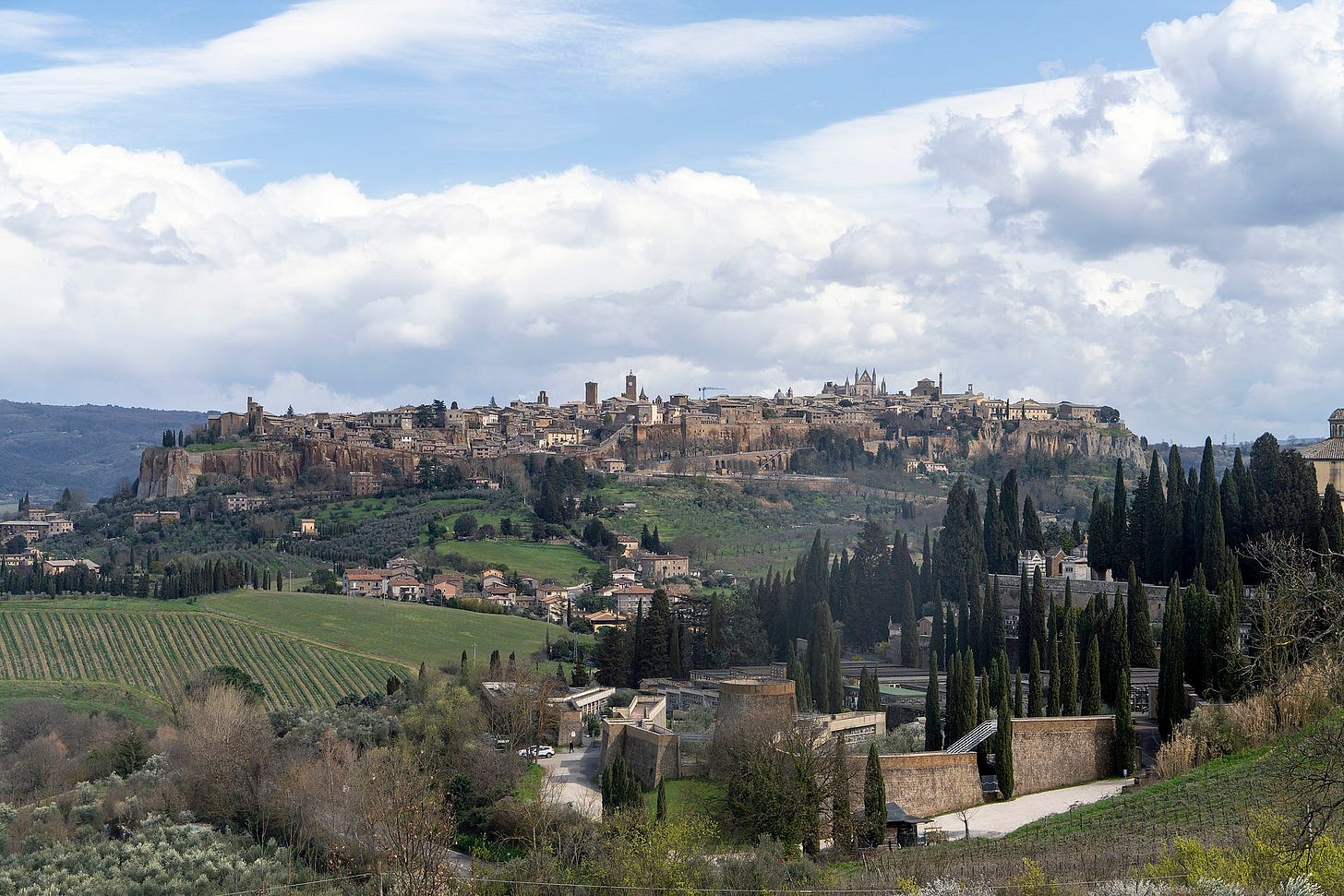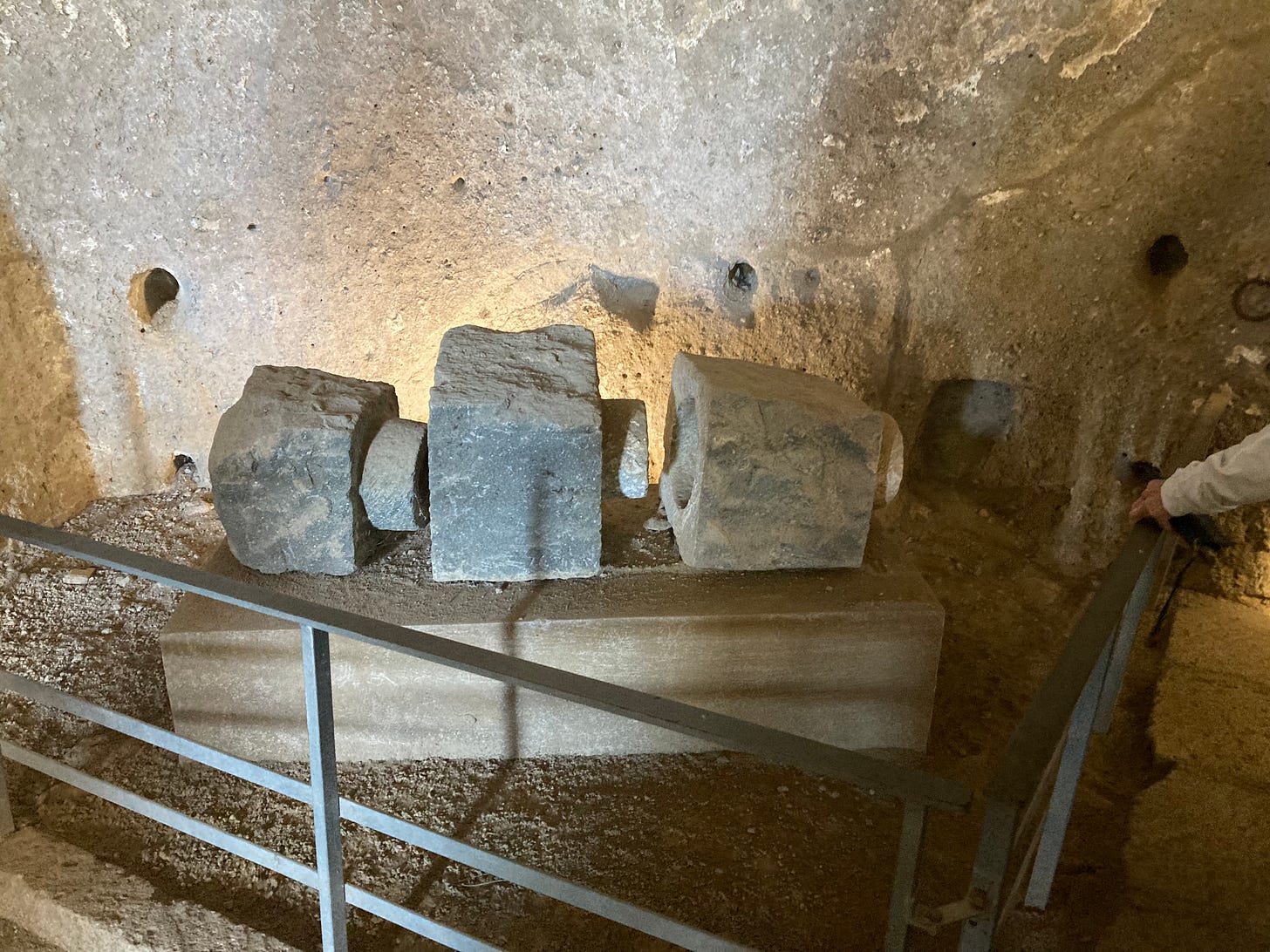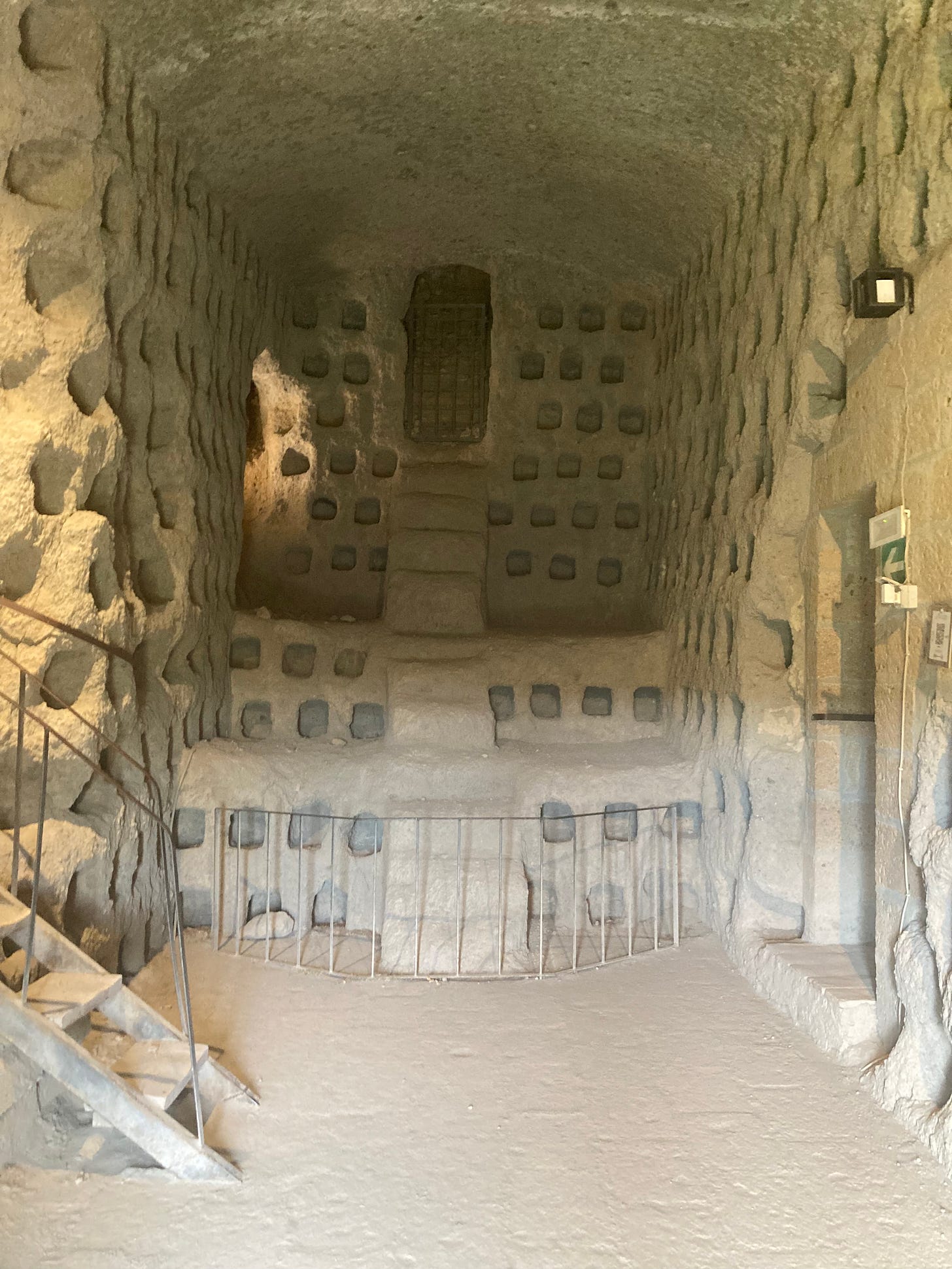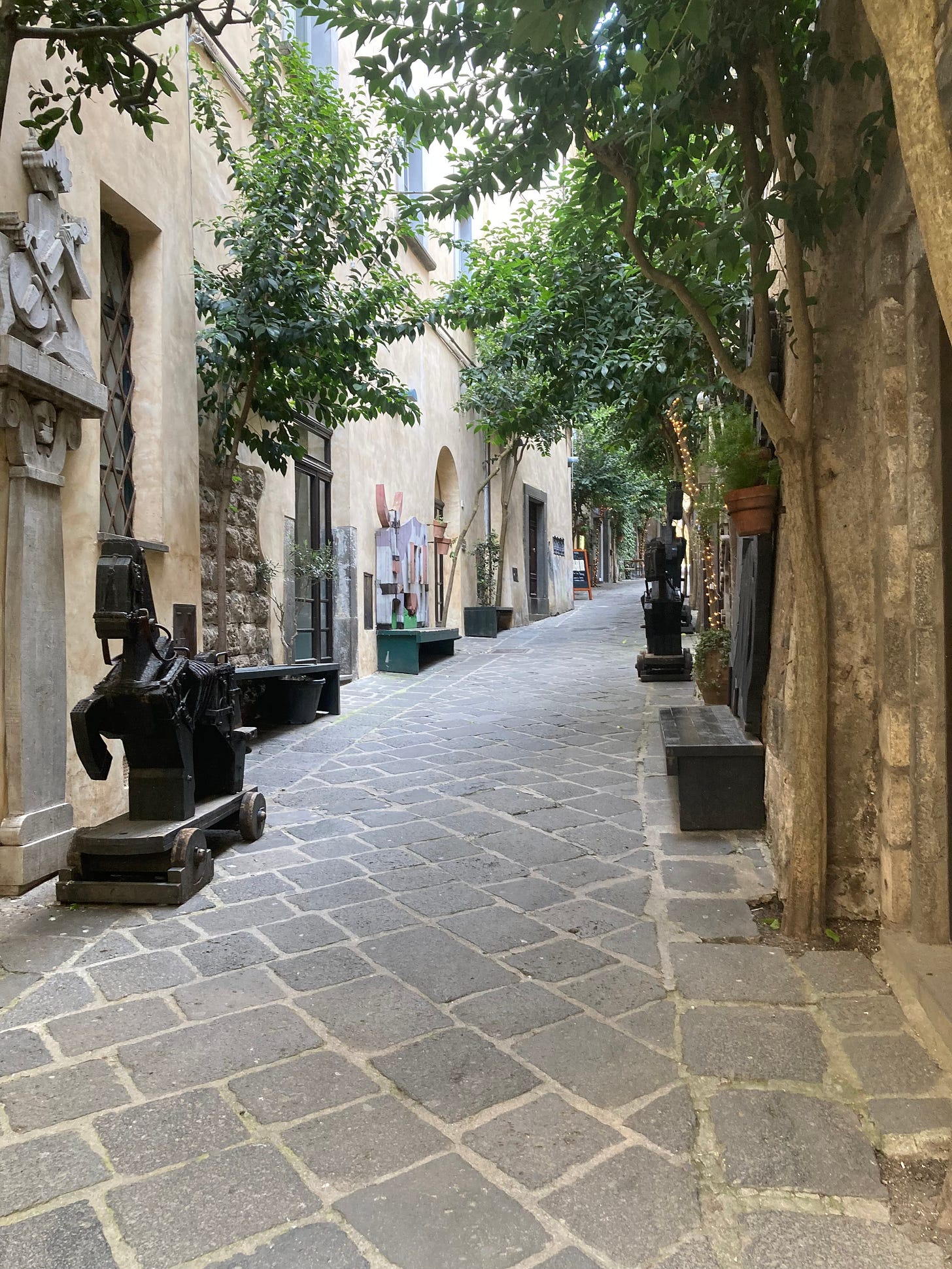A problem of subterranean pigeons
Funnelling [public resource into private hands in medieval Umbria
I am back from Italy but with plenty to keep writing and thinking about from my trip. Some of the experiences were very new, others familiar. Still others linked with things I knew from elsewhere. This is one of the latter.
A place I had never before visited was Orvieto, a medieval city that sits high on a plateau of volcanic tuff in the central Italian region of Umbria. Viewed across millennia, the settlement is an object lesson in how geology can shape culture and society, in a constant dialogue with human-scale change.

The city, high up on its tuff cliffs (in geological terms, a volcanic butte), sits in the midst of a wider plain of clay soils. Perching a city up above the surrounding environment presents various logistical challenges: there was always a cost-benefit analysis to be made. The biggest problems were, based on what people made the most effort to address:
Access
Water
Space
Access
Of course, access is the real crux of the issue. Somewhere that is difficult to get in and out of is both inconvenient and physically tough to live in, but is also inconvenient and physically tough to attack.

This was likely one of the reasons why the city became a major Etruscan centre in the second half of the first millennium BCE. This was a period of increasing warfare between different groups in the Italian peninsula, among which the Romans of Lazio would, by the end of the millennium, be ultimately victorious.
Its inaccessibility was definitely a critical factor in it becoming important again in the second half of the first millennium CE, as a centre for both Lombards and Goths, as Roman power in the Italian peninsula collapsed. From the tenth century it was self-governing, and throughout the Middle Ages had a large population of around 20,000-30,000. (This was large both by the standards of European cities of the time, and considering the very finite space available on the butte.)
Access, therefore, was never a problem worth solving completely, though today public buses and a funicular try their very best.

Water
For a high refuge to be of any use, especially for long-term settlement, the population also needs to have access to water. The geology of Orvieto is, again, a factor. Water naturally trickles through the extremely proud tuff but pools on the clay beneath. Thus, if you’re at the top, you need to reach the bottom to hit water. As a result, from the Etruscan period onwards, deep wells were dug down, as much as 90m.

The Pozzo di San Patrizio (Well of St Patrick) was a much bigger affair, completed in 1537 but for the same reason that had presumably motivated the Etruscans: to enable the city to sit out a lengthy siege. Whereas the Etruscans appear to have been happy to dig wells almost precisely the width of one man with a small pick, and then use buckets, the pope who commissioned St Patrick’s well (Clement VII, since you ask) went for a spiral design able to accommodate plural donkeys!
Space
Space to expand the population in a place like Orvieto is, by definition, limited, but multi-level houses, at least from the medieval period, were one way of addressing the issue. Today the population of around 20,000 is one third lower than at its probable high point and the medieval houses of Orvieto loom picturesquely over narrow streets.
Another way to gain space was to dig downwards into the soft limestone, as a medieval olive oil manufactory from the 13th century, now set up as museum exhibit, demonstrates. Not only did this move a pretty bulky operation out of the surface of the town, but the conditions in the cave, with its constant year-round temperature, could also generate a better-quality end product.
Orvieto Underground
The cave network beneath Orvieto is quite astounding. It has been described as ‘the city in negative’, since almost all of the material used to build the surface-level town was originally excavated from underneath them. In total there are more than 1200 caves.
By the 19th century the result was a total ban by the city on any further digging, due to repeated collapses and fears of growing instability. That was only the latest in a centuries-long process of negotiation over who gets to control, access or use the ground.
Orvieto underground is a perfect microcosm of debates which have been a constant in collective settlement: what belongs to all of us, what belongs to some of us? How are private versus public rights and obligations balanced against one another and also, something sometimes overlooked when these debates happen purely in the abstract, how are both balanced against the physical reality of a particular community?
Subterranean Pigeons and the Public/Private Funnel
Nowhere is this clearer than in the so-called columbaria or dovecotes beneath Orvieto. Each could house hundreds of pigeons, and if you’ve ever wondered about the economic benefit of pigeons, I have a reading to recommend.1 It is based on Anatolia rather than Italy, but pigeons are pretty much the same in both paces and so were their merits: they feed themselves, produce eggs, meat and down, which can be used for insulation, and their manure is a fantastic source of fertiliser.

In the 11th-13th centuries, columbaria (dovecotes) like these were excavated beneath houses that sat around the edge of the city. They were private. Each was accessed by a staircase leading down from the house above, while the birds flew free from their underground homes. They fed both the wealthy households which controlled them, and the rest of the population, who had to pay for the products which the birds provided.
Access to an underground dovecote turned control over the ground on which a house sat into control over a meaningful part of the local woods and fields in which the birds foraged, the water they drank on their daily forays, even the air through which they accessed the caves. They created a funnel, that sucked in public resources (water, woods and air) and turned them into private benefit (pigeons and their products).
Ironically, however, it was not this conflict between the private and the public which caused the closure of the columbaria. It was not even the very real possibility that they could cause the collapse of the city. (That fear came later, after many more centuries of excavation for other reasons.) It was the intersection of three other points of tension between public and private: waste, defence and taxes.
In the great circle of life, stuff is constantly moving from private to public. Public resources become private by being bought (like the land on which houses in Orvieto sat) or simply consumed. The private, from property to the contents of our own bodies and then our bodies themselves, also becomes, at some point, a public problem.
For millennia, while overall global population densities were low and the majority of what we consumed and produced was organic and perishable, waste was most often left to rot, burned or funnelled into rivers or the sea. The dead were often given special ritual treatment, but the same three solutions applied to their disposal and mostly the dead, like everything else produced by the living, stayed pretty close by.
People could build upwards and upwards in the same places generation after generation. It is why we so often find archaeological discoveries far below the level of modern cities and it is what makes tell sites like Çatalhöyük, now in Turkey, so special. They are hills, constructed, layer by layer out of the waste of the people who lived on them, so that it is possible to peel back human life over centuries.
In a city like Orvieto, the most obvious way to dispose of waste was simply to throw it over the edge, down to the plain below. That was, until the slopes of waste began to give access right into the columbaria windows, and then upwards into the houses of the city. Along with escape tunnels, built by various wealthy residents to let them out of the city in a siege, but which could also be used to break into the city if they fell into the wrong hands, the dovecotes became a vulnerability.
The official reason for demanding the columbaria be sealed from above was because each one might become a point of risk for the community as a whole. The passages up through the basements of these private houses, however, were also a way for traders to bring in goods without paying the city taxes that ultimately enriched both Orvieto itself and the papal state to which it by then belonged (we’re now into the later Middle Ages, post c. 1400).
Another negotiation we see across time between public and private is how the size and shape of the public collective affected people’s responses to it: smuggling arguably benefitted the people living in Orvieto, by providing access to cheaper goods, and many may not have cared that it would also undermine the now much larger unit of the papal state even if that also provided services to the community such as defence. Closed the columbaria were, though. The main gates of the city became the funnel through which private wealth (goods) could become, in part, public gain (taxes).
A public/private continuum?
In the final phase of the negative city, before tonnes of concrete needed to be pumped into its cracks in the late twentieth century to prevent further collapse, the caves served yet another public purpose, offering shelter for the population during the Second World War. Now, the caves remain a public resource, a managed archaeological site, tourist attraction and even wedding venue! (I would strongly recommend a tour if you are there.)

Debates today about how and when and why we own resources like water, the ground beneath our feet, or the wild animals that pass through the spaces we call our own are as old as legal codes concerning property. One way to look at the story of Orvieto is as a back and forth, between the private desire to exploit and the public need to limit harm. Another is to focus on the fluctuating capacity of various powers to organise the public in order to make meaningful claims on the private: the ability to impose taxes, to restrict excavation work, to organise coordinated tourist activity, versus times when those things have not been possible because of weakened government.
Another way to join the same dots might be to see the prioritisation of public good at the point when scarcity of resource (in the case of Orvieto, the scarcity of solid ground itself) means that unsustainable extraction by the few threatens not just to destabilise the many, but even the few themselves.
People have, historically, not always been very good at taking the long view, of thinking sustainably or at coordinating between lots of competing groups and levels in a society. More optimistically, though, we have frequently managed, however imperfectly, when the necessity is too hard to ignore!
Decker, Michael, ‘Frontier Settlement and Economy in the Byzantine East’, Dumbarton Oaks Papers, 61 (2007), 217–67.




